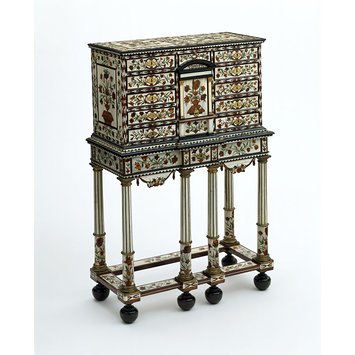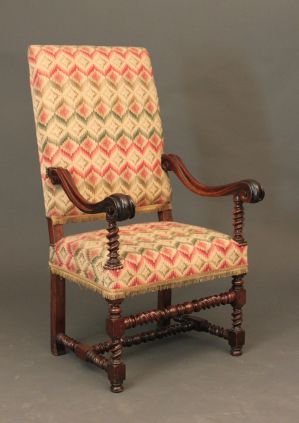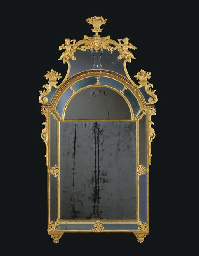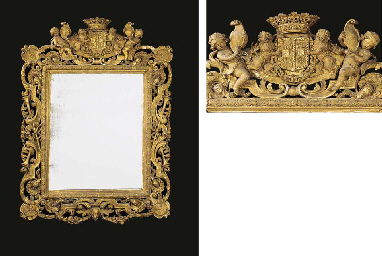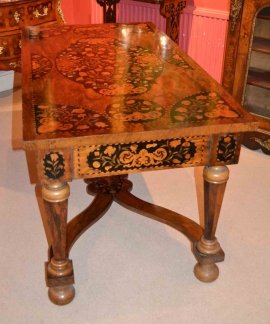Originating in Italy during the 10th century, where it was known as tarsia a incastro, meaning a combining of materials. Italian craftsmen are thought to have introduced to technique to France in around 1600 when they produced work for Marie de Medici, Henri IV's second wife. Pierre Gole, a cabinet maker from the Low Countries, is also credited with first using the technique in France.
Matching Pairs
Handmade furniture decorating with Boullework was quite often made in pairs, mainly because the process of cutting out the materials resulted in two complete sets of the marquetry design. Boulle marquetry was very time consuming, and making one set of designs, the premiere-partie, also produced an opposing set, the contre-partie - the most commonly seen examples are of matching cabinets.
Andre-Charles Boulle (1642-1732)
Cabinet maker to Louis XIV, Andre-Charles Boulle was responsible for many of the interior fittings and much of the furniture at the palace of Versailles.
Born in Paris, Boulle trained as a cabinet maker, an architect, a bronze worker, and engraver and obtained the royal privilege of lodging and working in the Louvre.
His most spectacular work perhaps was the design and creation of the of the mirrored walls, parquetry floors, inlaid panelling, and boullework non fitted furniture at the Palace of Versailles.
As well as Louis XIV, his patrons included many French dukes, King Philip V of Spain, and the Electors of both Bavaria and Cologne.
Boulle excelled at the marquetry that eventually took his name, although he was not the only cabinet maker developing this technique. His later designs were influenced by those of Jean Berain, an engraver who was also working at the Louvre, and it is often difficult to tell the work of the two craftsmen apart.
Berain usually incorporated swirling scrolls (arabesques) alongside figural images. His designs also have a more fanciful element than those of Boulle, with small grotesques and monkeys amongst the scrolling patterns. Very few pieces of furniture can definitely be attributed to Boulle himself.
Boulle was largely responsible for the development of new types of furniture, including the bureau and the commode, designs for which were published under the title Nouveaux Desseins de Meubles (New Designs of Furniture) and became widely known.
Louis XIV Boulle Commode
This commode is one of a pair made for Louis XIV's bedchamber at Trianon. It is veneered with ebony inlaid with brass. 17th century.

The Technique
To create Boulle marquetry, a design was first drawn up. Any wood being used, such as ebony, was cut into very thin slices to form a veneer. Tortoiseshell was flattened, then polished and often painted on the underside for colour.Any other materials were flattened in the same way, then cut into sheets the size of the marquetry pattern.
The tortoiseshell was then glued to a sheet of metal, such as pewter or brass, and wedged between two sheets of wood - like a sandwich. The design was then glued to one side of the 'sandwich' and the pattern was cut out of both the tortoiseshell and metal with a fretsaw. When the materials were separated from each other, the pieces of tortoiseshell and metal were sorted to form two marquetry sets - the brass details were set into the tortoiseshell background, known as the premiere-partie - and the tortoiseshell details were set into the brass background to form a reverse pattern, known as the contre-partie.
Once the marquetry veneer had been applied, the brass was engraved to add depth and detail. It was then rubbed down with sharkskin, which has a similar texture to sandpaper, and polished with a mixture of charcoal and oil. This process filled in the hollows of the engraving, making the design more pronounced.
The inner and outer panels of doors were frequently decorated in the same way. Sometimes Boulle used a mixture of both types of boullework on the same piece of furniture, now attempted with reproduction furniture The parts not decorated with boulle were often veneered in ebony, creating a striking contrast to the rest of the piece.
Finishing Touches
Boullework furniture was usually finished with gilded and engraved bronze mounts (known as ormolu). This was partly to protect the edges, legs, feet, and locks, which were the most vulnerable areas, and partly for decoration. The mounts were not usually made by the cabinet makers themselves, but by specialist foundries, which cast and shaped the metal before it was gilded.
Jean Berain (1638-1711)
A draughtsman, painter, designer, and engraver from the Low Countries, Jean Berain was appointed designer to Louis XIV in 1674. His workshop in the Louvre was near to that of Boulle, for whom he created many designs. During Louis XV's reign, Berain provided designs for furniture, weapons, theatrical costumes and sets, and even funeral processions.
Marquetry patterns with arabesques, scrolled foliage, or fanciful scenes were features of his work, and like Andre Boulle, he was inspired by Renaissance and Classical designs. The term 'berainesque' was coined to describe designs based on his inimitable style.


